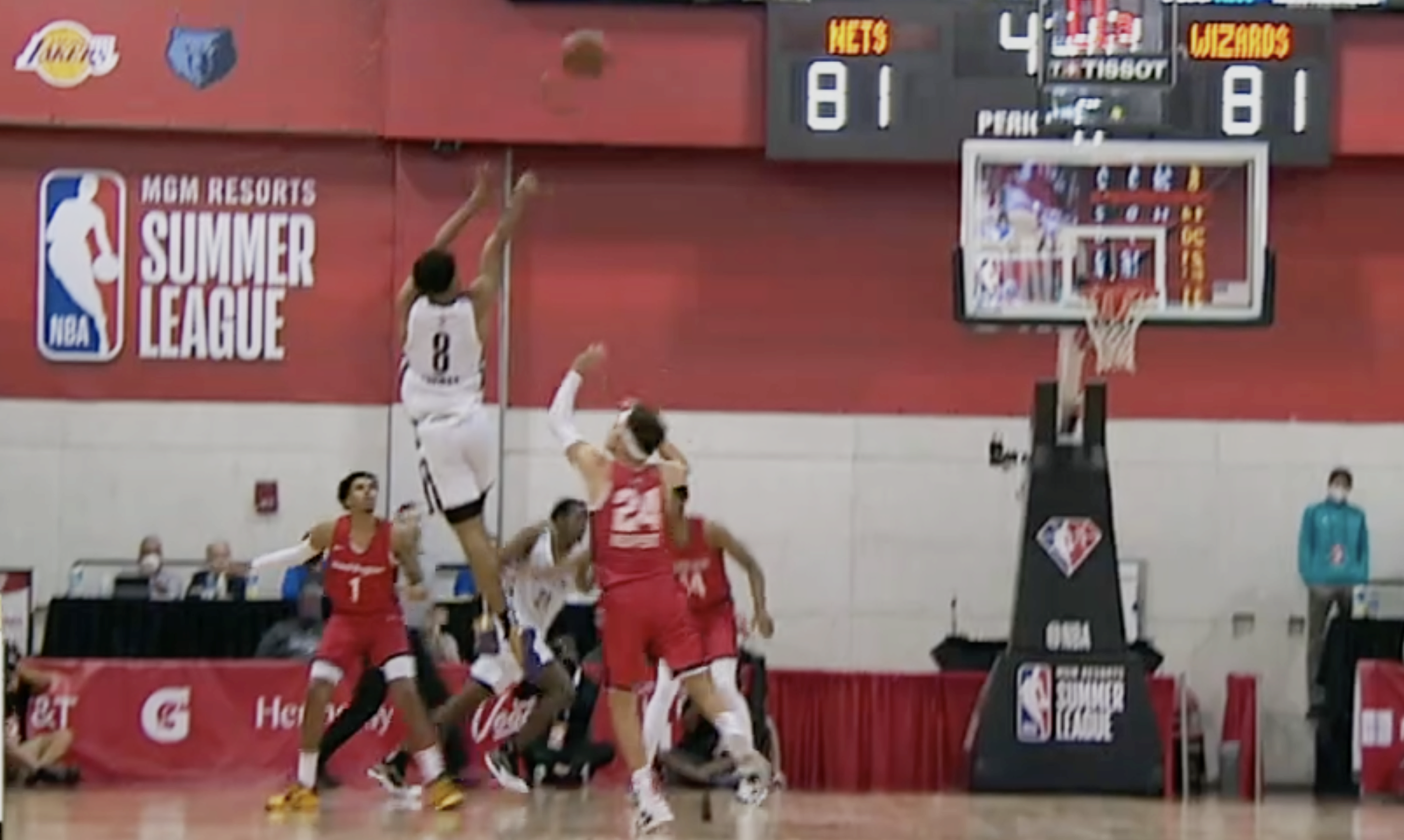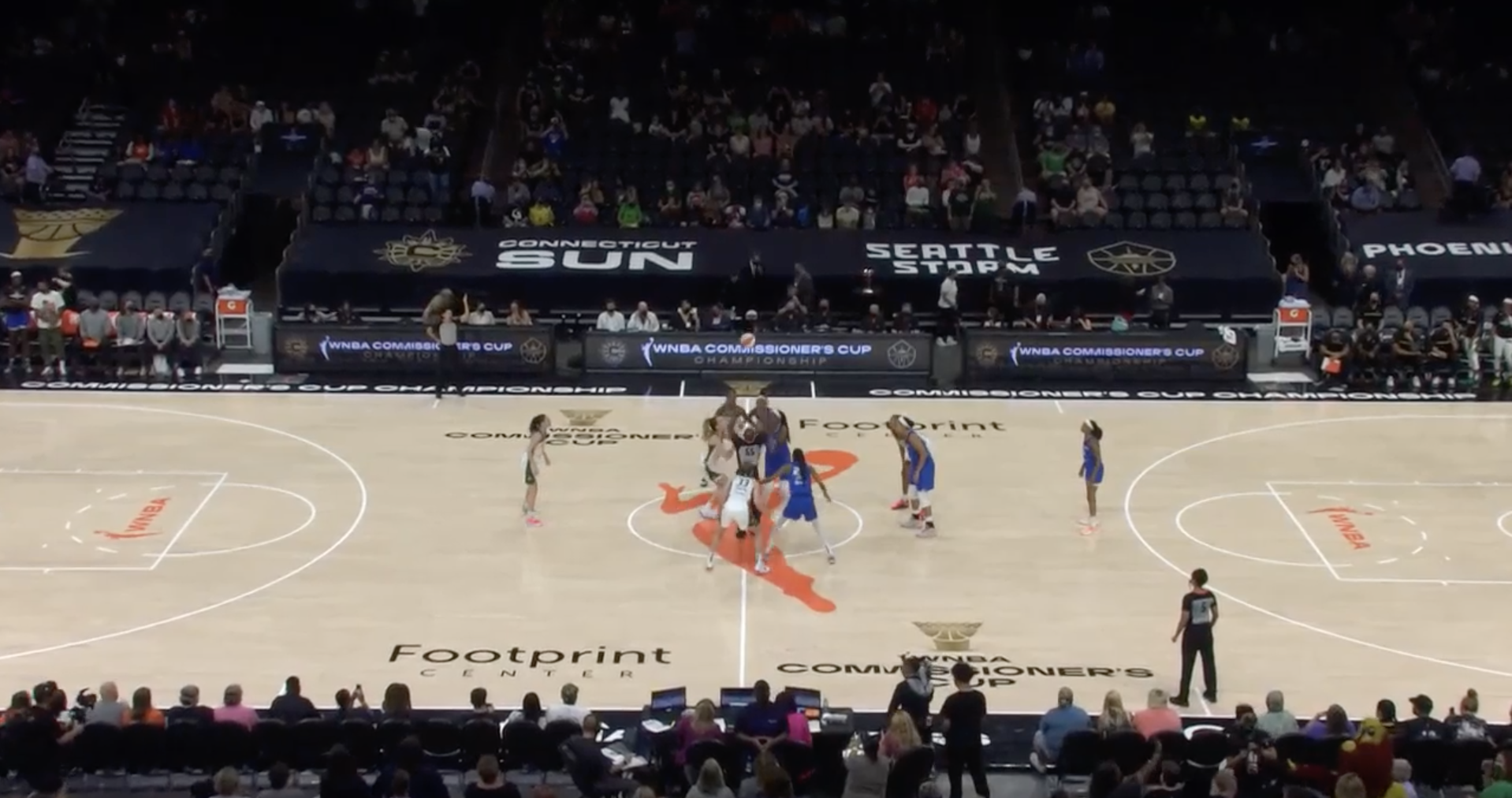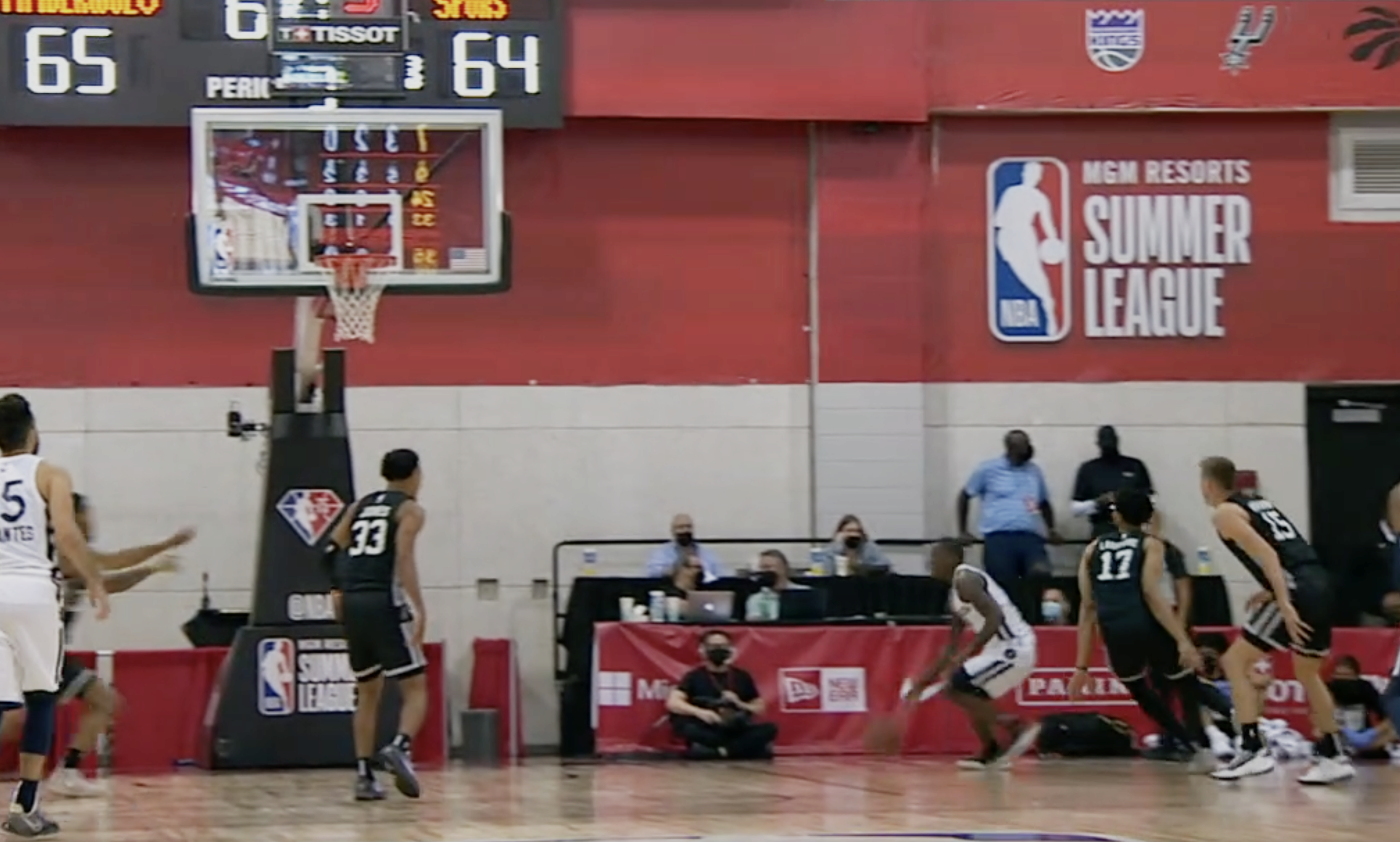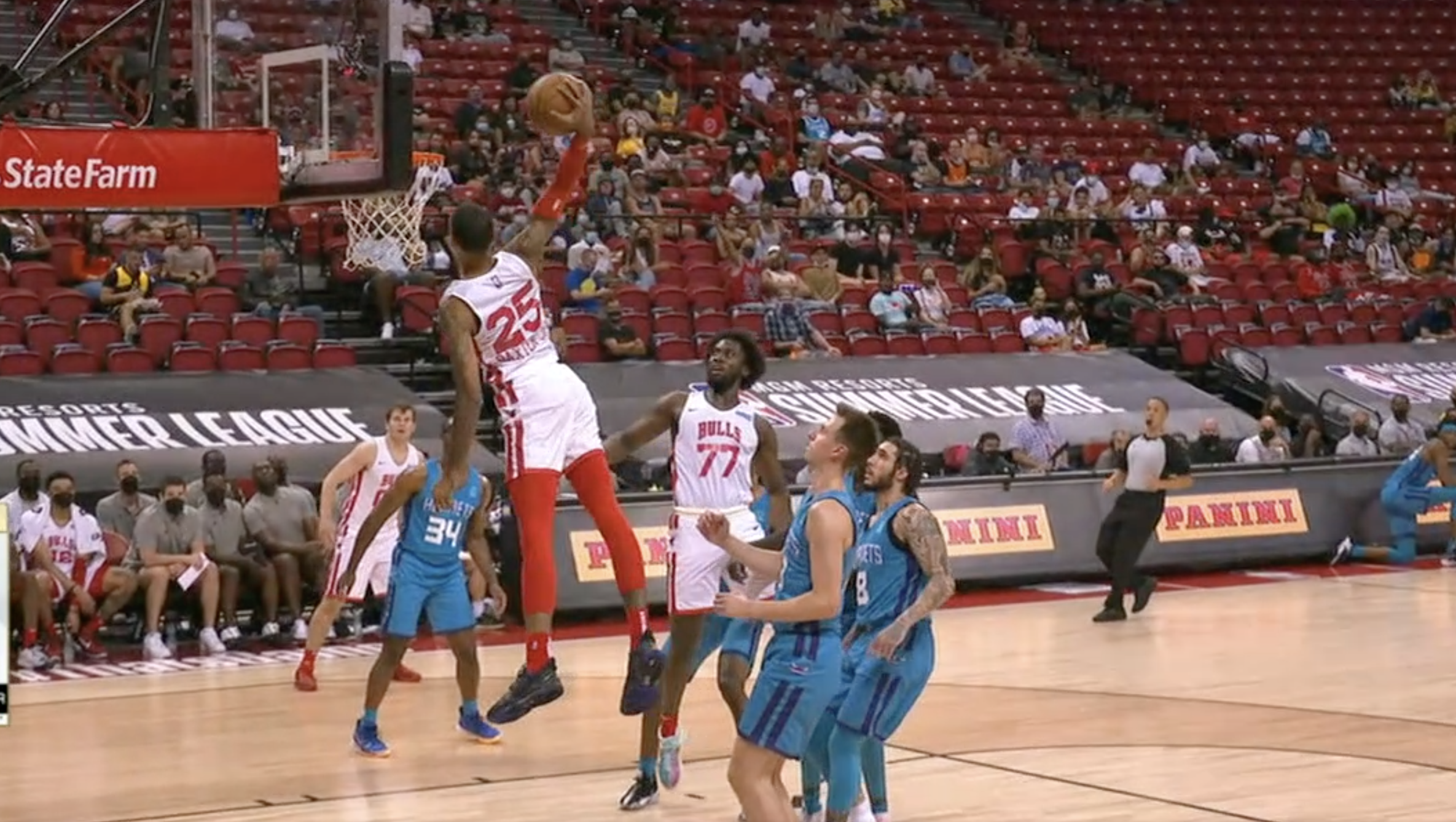NBA Looks to the Future With Hawk-Eye Tracking Tech at Summer League, WNBA Commissioner’s Cup
The goal is immersive fan experience, increased officiating accuracy and game flow
Story Highlights
This has a been a month of major technological innovation for the NBA and WNBA. First, at the NBA Summer League in Las Vegas, which wrapped up on Tuesday, the league undertook extensive testing of Sony’s Hawk-Eye next-gen tracking system for both broadcasting and game-ops applications. Then, the WNBA used Hawk-Eye tracking technology and Kinexon wearable sensors to create real-time broadcast enhancements at the inaugural WNBA Commissioner’s Cup Championship Game, which was live-streamed on Amazon Prime.
NBA Summer League: Hawk-Eye Streamlines Game Flow
Continuing the tradition of R&D at NBA Summer League, the league partnered with Hawk-Eye to create a product designed to serve a number of high-value basketball and broadcast applications.
Sony Hawk-Eye installed 14 cameras in the rafters of the Thomas & Mack Center in Vegas — some specifically targeting the rim, others covering the full court. The 14 cameras tracked 18 body-pose locations (a player’s head, hands, hips, etc.) as well as ball location in three dimensions with extremely precise accuracy.
“This is a continuation of a project that we call Precision Ball Tracking that we kicked off a couple of years ago,” says Tom Ryan, associate VP, basketball strategy analytics, NBA. “We’ve done some R&D prior to [Summer League], but this is really the most blown-out and developed version. The key goals of Precision Ball Tracking are twofold: first is officiating accuracy and perception; second is what we call game flow.”
For officiating accuracy, the league is looking to use highly precise 3D images of the ball to assist in close calls, such as goaltending, shot-clock resets, and stopping the clock after a made basket.
“Today, these situations are handled manually and depend on the human eye,” says Ryan. “We believe they are ripe for computer-vision applications. For purely objective calls, we hope to provide that data to aid the officials in the arena and at our replay center. Potentially, in the future, we could [institute] a red light that lights up when the system determines it is a goaltend. We’re looking to take some of those things off a ref’s plate that are very hard to determine in real time when you’re also trying to patrol the game.”
As for “perception,” the NBA is looking to create a precise, clean virtual replay for both refs and fans similar to Hawk-Eye’s work on tennis and soccer.

“Hawk-Eye’s bread and butter is being able to help make that decision and then educate fans, both in the arena and on the broadcast,” says Ryan. “We’ve seen it in soccer and tennis, and we believe we can have something similar: a clean visual that takes you into a virtual replay and shows it to you from different angles. That’s something we’re experimenting with and are very excited about both for broadcasts and in arenas.”
The “game-flow” aspect centers on the league and its Competition Committee’s efforts to create a better broadcast/streaming experience for fans by reducing unnecessary game stoppages. The NBA is looking for ways to plug the Hawk-Eye system into existing workflows at the NBA Replay Center in Secaucus, NJ, to streamline the operation.
“Wherever we can shave minutes or seconds off to create a cleaner and more consistent flow to the product,” says Ryan, “that’s where we look to change rules or implement technology. We think that having the data and technology from [Hawk-Eye] can streamline instant-replay reviews. In the future, hopefully, instead of going to the monitor to look at a potential goaltend for a minute or two, it’s just a red light, which makes for a lot better viewing experience for the fan.”
WNBA Commissioner’s Cup: Wearables Teamed With Hawk-Eye
 In addition to the NBA’s efforts in Vegas, the WNBA deployed both Hawk-Eye tracking technology and Kinexon wearable devices at the inaugural WNBA Commissioner’s Cup Championship Game last week at Phoenix’s Footprint Center. The NBA oversaw production of the game broadcast, which was live-streamed exclusively on Amazon Prime Video.
In addition to the NBA’s efforts in Vegas, the WNBA deployed both Hawk-Eye tracking technology and Kinexon wearable devices at the inaugural WNBA Commissioner’s Cup Championship Game last week at Phoenix’s Footprint Center. The NBA oversaw production of the game broadcast, which was live-streamed exclusively on Amazon Prime Video.
Using the same Hawk-Eye optical tracking technology deployed at NBA Summer League, the WNBA generated 3D immersive highlights, which were used in real time during the Amazon Prime Video broadcast.
“It’s the same underlying technology from Hawk-Eye,” Ryan notes, “but the end output is focused specifically on the broadcast and fan-engagement rather than on officiating. We are able to use that same technology to build immersive 3D highlights. Envision a step-back three or coast-to-coast fast break, and then imagine you are able to enter a virtual world where you can zoom and spin anywhere on the court to see that play.”
Ryan compares the highlights to the volumetric-capture tools that enable dynamic 360-degree views of key plays in sports broadcasts but says this will be even more immersive.
“With [Hawk-Eye], you can literally go anywhere on the court,” says Ryan. “You can go into the first-person view; you can be sitting on the backboard, anywhere in the area of play. This is the first time anyone has done these types of highlights in the actual broadcast. Others have done them in a halftime show or on a postgame, but this is the first time anyone is actually doing it during the broadcast. We’re really excited about that.”
 Also a first, the WNBA used in-game Kinexon wearable sensors (positioned in the waistband of the uniform shorts) to provide such data as how fast players sprint, how often they jump, and how quickly they change direction. Although the NBA has experimented with wearables for player health and performance needs in the G League for several years, this marks the first time they were used to generate next-gen metrics for fans.
Also a first, the WNBA used in-game Kinexon wearable sensors (positioned in the waistband of the uniform shorts) to provide such data as how fast players sprint, how often they jump, and how quickly they change direction. Although the NBA has experimented with wearables for player health and performance needs in the G League for several years, this marks the first time they were used to generate next-gen metrics for fans.
“We [used the wearables] to showcase performance data in the broadcast,” says Ryan, “using practical leaderboards and player cards that [showed] performance data such as number of jumps or how often they’re changing direction. We want to be able to quantify some of the things the viewer is seeing live so they can get a deeper understanding of the game.”
Looking Ahead: What Next-Gen Tracking Means for the Future of the Game
 For the mid to long term, Ryan sees plenty of promise for the Hawk-Eye tracking system to serve low-latency skeletal tracking technology. These types of systems could serve a wide spectrum of basketball-ops applications: identify potential biomechanical trends to avoid injuries, improve player health, create deeper analytics that provide new insights on player and team performance. And Ryan sees almost endless possibilities in terms of fan engagement and media.
For the mid to long term, Ryan sees plenty of promise for the Hawk-Eye tracking system to serve low-latency skeletal tracking technology. These types of systems could serve a wide spectrum of basketball-ops applications: identify potential biomechanical trends to avoid injuries, improve player health, create deeper analytics that provide new insights on player and team performance. And Ryan sees almost endless possibilities in terms of fan engagement and media.
“On the fan-engagement side, we feel that we’re still in the first inning with this [technology],” he says, “but we’re essentially turning basketball courts into motion-capture studios so there are truly endless possibilities for where you could take that motion-capture data. We can port it into immersive highlights, videogaming environments, metaverses, and all of those types of spaces to create different fan-engagement applications.”

